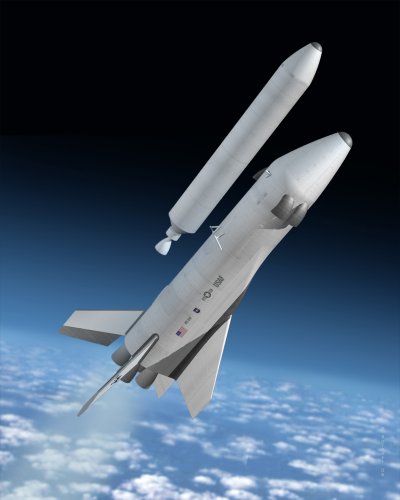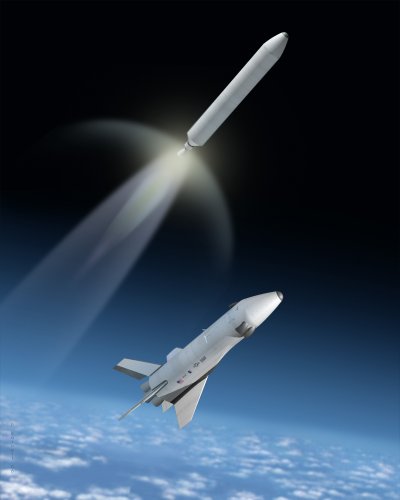- Joined
- 1 April 2006
- Messages
- 11,401
- Reaction score
- 10,329
potential ORS contender from NG?
Northrop Grumman Outlines Test Program to Advance Military Space Plane
EL SEGUNDO, Calif., June 16, 2004 (PRIMEZONE) -- Northrop Grumman Corporation (NYSE:NOC) will help the U.S. Air Force define the most cost-effective way to integrate and conduct ground tests on key structural elements of a reusable, quick-turnaround space vehicle.
The service hopes to use the demonstration to identify and mitigate technical and financial risks associated with developing and deploying a military space plane, an operationally responsive space vehicle that could launch payloads into orbit within hours of identifying a new mission requirement.
Under a six-month contract, Northrop Grumman will analyze and identify the technologies and costs required to construct and test a structural section of a reusable, winged space vehicle. The section would include a composite propellant tank, representative wingbox and vertical tail pieces, intertank structural members, structural health monitoring sensors, and demonstration zones of thermal protection system tiles.
"Over the past three years, Northrop Grumman has successfully developed and demonstrated key structural and vehicle health-management technologies required to build, launch and operate an affordable and reusable military space plane," said Doug Young, director of space programs for Northrop Grumman's Integrated Systems sector. "An integrated ground demonstration system would help identify and remove technical and financial barriers to producing, integrating and deploying this critical space asset."
The new study contract requires Northrop Grumman to identify the technical challenges and costs associated with conducting two different type of ground demonstrations: one based on the company's proposed Reusable Access to Space Technology (RAST) demonstrator vehicle; the other based on a micro-demonstrator concept developed by Los Angeles-based Conceptual Research Concepts.
Northrop Grumman's RAST concept is a rocket-propelled, two-stage-to-orbit space vehicle comprising a reusable, winged plane-like booster stage and a smaller, reusable winged orbiter. The space vehicle is designed to be launched repeatedly on short notice from a vertical position. The RAST booster stage flies back to the launch site using an integrated air-breathing jet engine. The orbiter stage can either place small payloads in low-earth orbit, or deploy a common aero vehicle (CAV) that can deliver conventional munitions to global targets within a few hours. Northrop Grumman is currently developing CAV design concepts as part of its work on a Defense Advanced Research Projects Agency/Air Force program called Force Application and Launch from Continental United States.
To date, Northrop Grumman has produced and demonstrated the structural integrity of composite cryogenic fuel tanks up to six feet in diameter, approximately the size tank envisioned for a military space plane. Composite fuel tanks are 10 to 25 percent lighter than comparably sized aluminum tanks, which enables increased payload-to-orbit lifting capabilities.
As part of that testing, funded by NASA's Next Generation Launch Technology program, the company also demonstrated the use of tank-mounted sensors to monitor the structural health of a composite structure, and some new methods for producing and installing metallic-based thermal protection panels on composite structures.
An automated structural health monitoring system would operate as part of an overall integrated vehicle health-monitoring system. It would provide an accurate assessment of a vehicle's structural integrity before launch, on orbit, and before re-entry and landing. It would also reduce the time and labor costs effort required to identify, locate and repair structural problems between military space plane missions.
Similarly, a thermal protection system is essential for protecting a military space plane and its contents from extreme temperature variations during all phases of a space mission. Northrop Grumman developed and refined its new thermal protection methodologies in collaboration with NASA Langley, Oceaneering Thermal Systems, NASA Marshall and M&P Technologies.
Northrop Grumman Integrated Systems is a premier aerospace and defense systems integration organization. Headquartered in El Segundo, Calif., it designs, develops, produces and supports integrated systems and subsystems optimized for use on networks. For its government and civil customers worldwide, Integrated Systems delivers best-value solutions, products and services that support military missions in the areas of intelligence, surveillance and reconnaissance; space access; battle management command and control; and integrated strike warfare.
More here http://www.is.northropgrumman.com/media/integrator_assets/Integrator_2004/i_jul12.pdf
http://www04.homepage.villanova.edu/jessica.byrnes/Exostar/i_apr10.pdf
Northrop Grumman Outlines Test Program to Advance Military Space Plane
EL SEGUNDO, Calif., June 16, 2004 (PRIMEZONE) -- Northrop Grumman Corporation (NYSE:NOC) will help the U.S. Air Force define the most cost-effective way to integrate and conduct ground tests on key structural elements of a reusable, quick-turnaround space vehicle.
The service hopes to use the demonstration to identify and mitigate technical and financial risks associated with developing and deploying a military space plane, an operationally responsive space vehicle that could launch payloads into orbit within hours of identifying a new mission requirement.
Under a six-month contract, Northrop Grumman will analyze and identify the technologies and costs required to construct and test a structural section of a reusable, winged space vehicle. The section would include a composite propellant tank, representative wingbox and vertical tail pieces, intertank structural members, structural health monitoring sensors, and demonstration zones of thermal protection system tiles.
"Over the past three years, Northrop Grumman has successfully developed and demonstrated key structural and vehicle health-management technologies required to build, launch and operate an affordable and reusable military space plane," said Doug Young, director of space programs for Northrop Grumman's Integrated Systems sector. "An integrated ground demonstration system would help identify and remove technical and financial barriers to producing, integrating and deploying this critical space asset."
The new study contract requires Northrop Grumman to identify the technical challenges and costs associated with conducting two different type of ground demonstrations: one based on the company's proposed Reusable Access to Space Technology (RAST) demonstrator vehicle; the other based on a micro-demonstrator concept developed by Los Angeles-based Conceptual Research Concepts.
Northrop Grumman's RAST concept is a rocket-propelled, two-stage-to-orbit space vehicle comprising a reusable, winged plane-like booster stage and a smaller, reusable winged orbiter. The space vehicle is designed to be launched repeatedly on short notice from a vertical position. The RAST booster stage flies back to the launch site using an integrated air-breathing jet engine. The orbiter stage can either place small payloads in low-earth orbit, or deploy a common aero vehicle (CAV) that can deliver conventional munitions to global targets within a few hours. Northrop Grumman is currently developing CAV design concepts as part of its work on a Defense Advanced Research Projects Agency/Air Force program called Force Application and Launch from Continental United States.
To date, Northrop Grumman has produced and demonstrated the structural integrity of composite cryogenic fuel tanks up to six feet in diameter, approximately the size tank envisioned for a military space plane. Composite fuel tanks are 10 to 25 percent lighter than comparably sized aluminum tanks, which enables increased payload-to-orbit lifting capabilities.
As part of that testing, funded by NASA's Next Generation Launch Technology program, the company also demonstrated the use of tank-mounted sensors to monitor the structural health of a composite structure, and some new methods for producing and installing metallic-based thermal protection panels on composite structures.
An automated structural health monitoring system would operate as part of an overall integrated vehicle health-monitoring system. It would provide an accurate assessment of a vehicle's structural integrity before launch, on orbit, and before re-entry and landing. It would also reduce the time and labor costs effort required to identify, locate and repair structural problems between military space plane missions.
Similarly, a thermal protection system is essential for protecting a military space plane and its contents from extreme temperature variations during all phases of a space mission. Northrop Grumman developed and refined its new thermal protection methodologies in collaboration with NASA Langley, Oceaneering Thermal Systems, NASA Marshall and M&P Technologies.
Northrop Grumman Integrated Systems is a premier aerospace and defense systems integration organization. Headquartered in El Segundo, Calif., it designs, develops, produces and supports integrated systems and subsystems optimized for use on networks. For its government and civil customers worldwide, Integrated Systems delivers best-value solutions, products and services that support military missions in the areas of intelligence, surveillance and reconnaissance; space access; battle management command and control; and integrated strike warfare.
More here http://www.is.northropgrumman.com/media/integrator_assets/Integrator_2004/i_jul12.pdf
http://www04.homepage.villanova.edu/jessica.byrnes/Exostar/i_apr10.pdf


